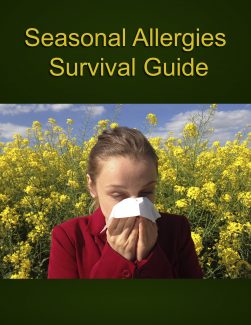
 License Type: Private Label Rights
License Type: Private Label Rights  File Type: ZIP
File Type: ZIP
 SKU: 61719
SKU: 61719  Shipping: Online Download
Shipping: Online Download
Sample Content Preview
Introduction
If you have allergies, you know how negatively they can impact your quality of life. If you have seasonal allergies, they can make life a misery and slow you down from getting on with your regular activities, seemingly powerless to combat nature. But what are seasonal allergies? And what can you do to get relief from your symptoms?
What Are Seasonal Allergies?
Seasonal allergies develop when the body’s immune system becomes sensitive to and then overreacts to something in the environment. These triggers will not typically cause any problem in most people, but sets off a violent reaction in a person with the allergy. Around 36 million Americans have seasonal allergies.
Seasonal allergies relate to triggers that appear at various times during the year, such as hay fever in the spring. You can have seasonal allergies all year round, but there are certain times of year when certain triggers arrive.
If you cough and sneeze a lot at certain times of year, and/or your nose and eyes itch and are runny, it may not be a cold or the flu causing your misery, but rather seasonal allergies.
Common Allergy Symptoms to Look Out For
There are a number of allergy symptoms to look out for, not all of them typical:
* Congestion
* Post-nasal drip
* Excess mucus production
* Sneezing
* Runny nose
* Itchy, watery eyes
* Scratchy throat
* Tickle/irritation in the ears
* Decreased concentration and focus
* Decreased decision-making abilities
* Exhaustion and sleep disorders
* Mood swings
* Irritability
* Low blood pressure
* Asthma
* Hives
* Eczema
* Middle ear infections
* Swollen glands in the neck
What Are the Most Common Seasonal Allergens?
Mold, flower, tree, grass, weed pollen and ragweed are the most common triggers of seasonal allergies.
When Is Allergy Season in the Northern Hemisphere?
Allergy season typically starts in late February and lasts until early summer, then picks again in the autumn.
Flowers begin to bud in the earlier months of the year, such as late February. Tree pollen also starts early in the spring, and can leave your car covered with fluffy green tufts if you park under a pollinating tree.
Grass can also trigger allergies in late spring and early summer. Weeds thrive throughout the spring and early summer. Spring can be a truly miserable time for people with allergies.
If the winter has been a wet one, and/or the spring is a very rainy one, mold can go mad and grow rapidly. In this case, mold allergies can last right through until the fall.
In the autumn, ragweed is on the rise. It’s a weed that grows in the US from the East Coast to the Midwest. It blooms from August to November, with peak activity in September each year, just at the time everyone has to head back to work or school after the summer vacation.







